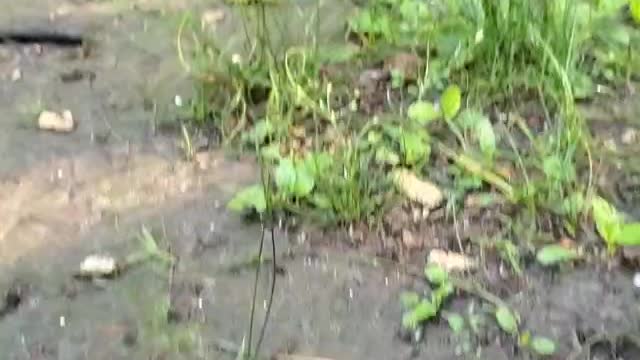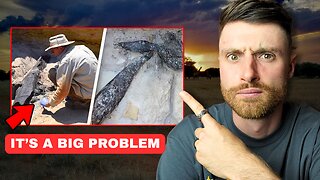Premium Only Content

Squirrel is a small cute animal that everyone like.
The word "squirrel", first attested in 1327, comes from the Anglo-Norman esquirel which is from the Old French escurel, the reflex of a Latin word sciurus, which was taken from the Ancient Greek word σκίουρος (from σκία-ουρος), skiouros, "shadow-tailed", referring to the long bushy tail which many of its members have.[2][3]
The native Old English word for the squirrel, ācweorna, survived only into Middle English (as aquerne) before being replaced.[4] The Old English word is of Common Germanic origin, cognates of which are still used in other Germanic languages, including the German Eichhörnchen (diminutive of Eichhorn, which is not as frequently used), the Norwegian ikorn/ekorn, the Dutch eekhoorn, the Swedish ekorre and the Danish egern.
A group of squirrels is called a "dray"[5] or a "scurry".[6]
Characteristics
Reaching out for food on a garden bird feeder, this squirrel can rotate its hind feet, allowing it to descend a tree head-first.
Skull of an Oriental giant squirrel (genus Ratufa)—note the classic sciuromorphous shape of the anterior zygomatic region.
Squirrels are generally small animals, ranging in size from the African pygmy squirrel and least pygmy squirrel at 10–14 cm (3.9–5.5 in) in total length and just 12–26 g (0.42–0.92 oz) in weight,[7][8] to the Bhutan giant flying squirrel at up to 1.27 m (4 ft 2 in) in total length,[9] and several marmot species, which can weigh 8 kg (18 lb) or more.[10][11] Squirrels typically have slender bodies with very long very bushy tails and large eyes. In general, their fur is soft and silky, though much thicker in some species than others. The coat color of squirrels is highly variable between—and often even within—species.[12]
In most squirrel species, the hind limbs are longer than the fore limbs, while all species have either four or five toes on each foot. The feet, which include an often poorly developed thumb, have soft pads on the undersides[13] and versatile, sturdy claws for grasping and climbing.[14] Tree squirrels, unlike most mammals, can descend a tree head-first. They do so by rotating their ankles 180 degrees, enabling the hind feet to point backward and thus grip the tree bark from the opposite direction.[15]
Squirrels live in almost every habitat, from tropical rainforest to semiarid desert, avoiding only the high polar regions and the driest of deserts. They are predominantly herbivorous, subsisting on seeds and nuts, but many will eat insects and even small vertebrates.[16]
As their large eyes indicate, squirrels have an excellent sense of vision, which is especially important for the tree-dwelling species. Many also have a good sense of touch, with vibrissae on their limbs as well as their heads.[13]
The teeth of sciurids follow the typical rodent pattern, with large incisors (for gnawing) that grow throughout life, and cheek teeth (for grinding) that are set back behind a wide gap, or diastema. The typical dental formula for sciurids is
1.0.1.3
1.0.1.3
.[17]
Many juvenile squirrels die in the first year of life. Adult squirrels can have a lifespan of 5 to 10 years in the wild. Some can survive 10 to 20 years in captivity.[18] Premature death may be caused when a nest falls from the tree, in which case the mother may abandon her young if their body temperature is not correct. Many such baby squirrels have been rescued and fostered by a professional wildlife rehabilitator until they could be safely returned to the wild,[19] although the density of squirrel populations in many places and the constant care required by premature squirrels means that few rehabilitators are willing to spend their time doing this and such animals are routinely euthanized instead.
Stated purposes of squirrels' tails, to benefit the squirrel, include:[20]
To keep rain, wind, or cold off itself.
To cool off when hot, by pumping more blood through its tail.
As a counterbalance when jumping about in trees.
As a parachute when jumping.
To signal with.
The hairs from squirrel tails are prized in fly fishing when tying fishing flies. A special quality of squirrel tail hair is that it is all guard hairs, not undercoat.
When the squirrel is sitting upright, its tail folded up its back may stop predators looking from behind from seeing the characteristic shape of a small mammal.
Squirrel enjoying in the sun.
Squirrel in Chandigarh.
Squirrel near Chandigarh.
Squirrel on mango tree.
-
 18:55
18:55
GritsGG
11 hours agoFastest Killing Warzone SMG!
4.15K -
 LIVE
LIVE
Lofi Girl
2 years agoSynthwave Radio 🌌 - beats to chill/game to
253 watching -
 12:48
12:48
The Pascal Show
8 hours ago $0.10 earnedEX FILES RESTRAINING ORDER! Jake Haro's EX Files Amid Search For Missing Emmanuel Haro
4.54K -
 16:22
16:22
Michael Button
7 days ago $1.66 earnedThe Timeline of Civilization is Completely Wrong
15.8K3 -
 10:02
10:02
Liberty Hangout
14 days agoPaid Protestors Silence Reasonable Democrat
43.3K59 -
 2:17:55
2:17:55
FreshandFit
6 hours agoMr Organik Vs Garry The Numbers Guy “N Word” Debate!
102K13 -
 2:05:11
2:05:11
Inverted World Live
9 hours agoCyborg Jellyfish, Cockroach Spies, and the Humanoid Holocaust w/ Joe Allen | Ep. 96
101K14 -
 3:30:50
3:30:50
Laura Loomer
9 hours agoEP139: Loomer Shuts Down Gazan Visas
42.5K85 -
 2:48:44
2:48:44
TimcastIRL
9 hours agoTrump Claims Total Victory, Court Eliminates $500M Fine In NY Fraud Case | Timcast IRL
193K83 -
 6:02:30
6:02:30
SpartakusLIVE
10 hours agoVerdansk QUADS || #1 MACHINE is BACK taking NO DAYS OFF (until I feel like it)
56K